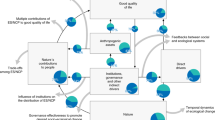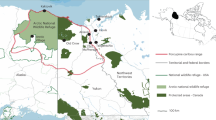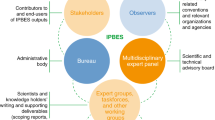Abstract
The need to understand nature’s contributions to people and across a broad spectrum of cultures and ecosystems is increasingly advocated in science assessments and policy decision-making for sustainability. However, for services such as food and medicine, gaps in existing studies on indigenous and local knowledge may preclude inclusive assessments. Here, using a large database of indigenous and local knowledge about plant services for New Guinea, we show that there are biological and cultural documentation gaps that will exclude many plant services and indigenous groups from assessments that are based solely on published research. Further, we unveil that, like the common property of ‘rarity’ in species assemblages, most plant services exhibit high rarity. Gaps and rarity are probably pervasive in other regions and will affect how plant services are conceptualized, assessed and sustainably managed.
This is a preview of subscription content, access via your institution
Access options
Access Nature and 54 other Nature Portfolio journals
Get Nature+, our best-value online-access subscription
$29.99 / 30 days
cancel any time
Subscribe to this journal
Receive 12 digital issues and online access to articles
$119.00 per year
only $9.92 per issue
Buy this article
- Purchase on Springer Link
- Instant access to full article PDF
Prices may be subject to local taxes which are calculated during checkout




Similar content being viewed by others
Data availability
The data of ILK about plant services for New Guinea that was generated and analysed during the current study is available from the corresponding author on reasonable request. Language data are available from the Ethnologue (ref. 10), elevation data are available from CGIAR-CSI (ref. 40) and ecoregion data are available from WWF (ref. 41).
References
Convention on Biological Diversity (United Nations,1992); https://www.cbd.int/doc/legal/cbd-en.pdf.
Díaz, S. et al. Assessing nature’s contributions to people. Science 359, 270–272 (2018).
Karki, M., Senaratna Sellamuttu, S., Okayasu, S. & Suzuki, W. (eds) The IPBES Regional Assessment Report on Biodiversity and Ecosystem Services for Asia and the Pacific (Secretariat of the Intergovernmental Science-Policy Platform on Biodiversity and Ecosystem Services, 2018).
Shaw, R., Takeuchi, Y., Uy, N. & Sharma, A. Indigenous Knowledge: Disaster Risk Reduction Policy Note (UNISDR Asia and the Pacific, 2009).
Gadgil, M., Ferkes, B. & Folke, C. Indigenous knowledge for biodiversity conservation. Ambio 22, 151–156 (1993).
Lauer, M. & Aswani, S. Indigenous knowledge and long-term ecological change: detection, interpretation, and responses to changing ecological conditions in Pacific island communities. Environ. Manag. 45, 985–997 (2010).
Garnett, S. T. et al. A spatial overview of the global importance of indigenous lands for conservation. Nat. Sustain. 1, 369 (2018).
Soberón, J. & Peterson, A. T. Biodiversity governance: a tower of babel of scales and cultures. PLoS Biol. 13, e1002108 (2015).
Loh, J. & Harmon, D. A global index of biocultural diversity. Ecol. Indic. 5, 231–241 (2005).
Simons, G. F. & Fennig, C. D. (eds) Ethnologue: Languages of the World 21st edn (SIL International, 2018); http://www.ethnologue.com
Cabuy, R. L., Marwa, J., Manusawai, J. & Rahawarin, Y. Y. Non-woody plant species of Papuan island forests, a sustainable source of food for the local communities. Indian J. Tradit. Know. 11, 586–592 (2012).
Berkes, F., Colding, J. & Folke, C. Rediscovery of traditional knowledge as adaptive management. Ecol. Appl. 10, 1251–1262 (2000).
Gorenflo, L. J. et al. Co-occurrence of linguistic and biological diversity in biodiversity hotspots and high wilderness areas. Proc. Natl Acad. Sci. USA 109, 8032–8037 (2012).
Mittermeier, R. A. et al. Biodiversity hotspots and major tropical wilderness areas: approaches to setting conservation priorities. Conserv. Biol. 12, 516–520 (1998).
Paijmans, K. New Guinea Vegetation (Commonwealth Scientific and Industrial Research Organization in association with the Australian National University Press, 1976).
Raven, P. H., Berlin, B. & Breedlove, D. E. The origins of taxonomy. Science 174, 1210–1213 (1971).
Loh, J. & Harmon, D. Biocultural Diversity: Threatened Species, Endangered Languages (WWF Netherlands, 2014).
Rabinowitz, D. in The Biological Aspects of Rare Plant Conservation (ed. Synge, H.) 205–217 (Wiley, 1981).
Davis, W., Harrison, K. D. & Howell, C. H. (eds) Book of Peoples of the World: A Guide to Cultures (National Geographic Books, 2007).
Cámara-Leret, R. et al. Ethnobotanical knowledge is vastly under-documented in northwestern South America. PLoS ONE 9, e85794 (2014).
Teixidor-Toneu, I. et al. An ethnomedicinal survey of a Tashelhit-speaking community in the High Atlas, Morocco. J. Ethnopharmacol. 188, 96–110 (2016).
Calvet-Mir, L. et al. The contribution of traditional agroecological knowledge as a digital commons to agroecological transitions: the case of the CONECT-e platform. Sustainability 10, 3214 (2018).
Dekens, J. Local Knowledge for Disaster Preparedness: A Literature Review (International Centre for Integrated Mountain Development, 2007).
Gómez‐Baggethun, E. et al. Traditional ecological knowledge trends in the transition to a market economy: empirical study in the Doñana natural areas. Conserv. Biol. 24, 721–729 (2010).
Rounsevell, M., Fischer, M., Torre-Marin Rando, A. & Mader, A. (eds) The IPBES Regional Assessment Report on Biodiversity and Ecosystem Services for Europe and Central Asia (Secretariat of the Intergovernmental Science-Policy Platform on Biodiversity and Ecosystem Services, 2018).
People’s Biodiversity Register (National Biodiversity Authority, 2013).
Waldron, A. et al. Targeting global conservation funding to limit immediate biodiversity declines. Proc. Natl Acad. Sci. USA 110, 12144–12148 (2013).
Cámara-Leret, R. et al. Fundamental species traits explain provisioning services of tropical American palms. Nat. Plants 3, 16220 (2017).
Howitt, R. Indigenous rights vital to survival. Nat. Sustain. 1, 339–340 (2018).
Warburg, O. Beitrage zur kenntnis der papuanischen flora. Bot. Jahrb. Syst. 13, 230–455 (1891).
Brummitt R. K., Pando F., Hollis S. & Brummitt N. A. World Geographical Scheme for Recording Plant Distributions. International Working Group on Taxonomic Databases for Plant Sciences (TDWG) (Royal Botanic Gardens Kew, 2001).
Hide, R. A Preliminary Bibliography of Ethnobotanical Research in West Papua (Indonesia), Part I: Publications 2000–2013 (2014).
Hide, R. A Preliminary Bibliography of Ethnobotanical Research in West Papua (Indonesia), Part II: Publications 1963–1999 (2014).
Hide, R. Supplement 1 to ‘A Preliminary Bibliography of Ethnobotanical Research in West Papua (Indonesia), Part I: Publications 2000–2013 (2015).
Hide, R. Supplement 2 to ‘A Preliminary Bibliography of Ethnobotanical Research in West Papua (Indonesia), Part I: Publications 2000–2013 (2016).
Hide, R. Supplement 3 to ‘A Preliminary Bibliography of Ethnobotanical Research in West Papua (Indonesia), Part I: Publications 2000–2013 (2016).
Hide, R. Supplement 4 to ‘A Preliminary Bibliography of Ethnobotanical Research in West Papua (Indonesia), Part I: Publications 2000–2013 (2017)
Thiers, B. Index Herbariorum: A Global Directory of Public Herbaria and Associated Staff. New York Botanical Garden’s Virtual Herbarium (New York Botanical Garden, 2018); http://sweetgum.nybg.org/ih/
Cook, F. Economic Botany Data Collection Standard. Prepared for the International Working Group on Taxonomic Databases for Plant Sciences (TDWG) (Royal Botanic Gardens Kew, 1995).
Indigenous and Tribal Peoples Convention, 1989 Report No. 169 (International Labour Organisation, 1989); http://www.ilo.org/dyn/normlex/en/f?p=NORMLEXPUB:12100:0::NO::P12100_ILO_CODE:C169
Jarvis, A., Reuter, H. I., Nelson, A. & Guevara, E. SRTM 90m DEM Digital Elevation Database Version 4 (accessed March 2019); http://srtm.csi.cgiar.org
Olson, D. M. et al. Terrestrial ecoregions of the world: a new map of life on earth. Bioscience 51, 933–938 (2001).
R Core Team A Language and Environment for Statistical Computing (R Foundation for Statistical Computing, 2019).
Hijmans, R. et al. raster: Geographic Data Analysis and Modeling. R Package version 2.8-19 (2019).
Bivand, R. et al. rgdal: Bindings for the ‘Geospatial’ Data Abstraction Library. R Package version 1.4-3 (2019).
Hijmans, R. Williams, E. & Vennes, C. geosphere: Spherical Trigonometry. R Package version 1.5-7 (2017).
Lewis, M. P. & Simons, G. F. Assessing endangerment: expanding fishman’s GIDS. Rev. Roum. Linguist. 55, 103–120 (2010).
Bastian, M., Heymann, S., Jacomy, M. Gephi: an open source software for exploring and manipulating networks. In Proc. 3rd International AAAI Conference on Weblogs and Social Media 361–362 (AAAI, 2009); https://www.aaai.org/ocs/index.php/ICWSM/09/paper/view/154
Acknowledgements
We thank D. Frodin and the staff at the Library, Art and Archives Department of Royal Botanic Gardens Kew for assistance in finding references. We extend our gratitude to: L. Green (Royal Botanic Gardens Kew Digital Collections Unit) and S. Arias (Naturalis Biodiversity Center) for assistance with herbarium databases; K. Willis and T. Ulian for support; I. Olivares for reviewing earlier versions of this manuscript; and I. Cámara for assistance with the design-layout of figures.
Author information
Authors and Affiliations
Contributions
R.C.-L. conceived the study. Z.D. and R.C.-L. collected data. R.C.-L. analysed the data. R.C.-L. wrote the paper. Both authors discussed the results and commented on the manuscript.
Corresponding author
Ethics declarations
Competing interests
The authors declare no competing interests.
Additional information
Publisher’s note: Springer Nature remains neutral with regard to jurisdictional claims in published maps and institutional affiliations.
Supplementary Information
Supplementary Information
Supplementary Fig. 1, Supplementary Tables 1 and 2.
Rights and permissions
About this article
Cite this article
Cámara-Leret, R., Dennehy, Z. Information gaps in indigenous and local knowledge for science-policy assessments. Nat Sustain 2, 736–741 (2019). https://doi.org/10.1038/s41893-019-0324-0
Received:
Accepted:
Published:
Issue Date:
DOI: https://doi.org/10.1038/s41893-019-0324-0
This article is cited by
-
Networked media and information ocean literacy: a transformative approach for UN ocean decade
npj Ocean Sustainability (2024)
-
Bridging local and scientific knowledge for area-based conservation of useful plants in Colombia
Ambio (2024)
-
Potential for conservation of threatened Brazilian Myrtaceae through sustainable use for food and medicine
Environment, Development and Sustainability (2023)
-
The Politics of Indigenous Environmental Knowledge in Vietnam
Human Ecology (2022)
-
Conserving evolutionarily distinct species is critical to safeguard human well-being
Scientific Reports (2021)



